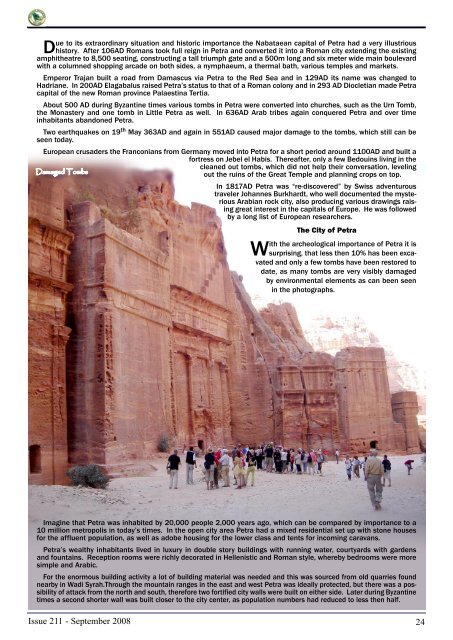& It's Petra Capital The Nabataean Culture
& It's Petra Capital The Nabataean Culture
& It's Petra Capital The Nabataean Culture
Create successful ePaper yourself
Turn your PDF publications into a flip-book with our unique Google optimized e-Paper software.
Due to its extraordinary situation and historic importance the <strong>Nabataean</strong> capital of <strong>Petra</strong> had a very illustrious<br />
history. After 106AD Romans took full reign in <strong>Petra</strong> and converted it into a Roman city extending the existing<br />
amphitheatre to 8,500 seating, constructing a tall triumph gate and a 500m long and six meter wide main boulevard<br />
with a columned shopping arcade on both sides, a nymphaeum, a thermal bath, various temples and markets.<br />
Emperor Trajan built a road from Damascus via <strong>Petra</strong> to the Red Sea and in 129AD its name was changed to<br />
Hadriane. In 200AD Elagabalus raised <strong>Petra</strong>’s status to that of a Roman colony and in 293 AD Diocletian made <strong>Petra</strong><br />
capital of the new Roman province Palaestina Tertia.<br />
About 500 AD during Byzantine times various tombs in <strong>Petra</strong> were converted into churches, such as the Urn Tomb,<br />
the Monastery and one tomb in Little <strong>Petra</strong> as well. In 636AD Arab tribes again conquered <strong>Petra</strong> and over time<br />
inhabitants abandoned <strong>Petra</strong>.<br />
Two earthquakes on 19 th May 363AD and again in 551AD caused major damage to the tombs, which still can be<br />
seen today.<br />
European crusaders the Franconians from Germany moved into <strong>Petra</strong> for a short period around 1100AD and built a<br />
fortress on Jebel el Habis. <strong>The</strong>reafter, only a few Bedouins living in the<br />
cleaned out tombs, which did not help their conversation, leveling<br />
Damaged Tombs<br />
out the ruins of the Great Temple and planning crops on top.<br />
In 1817AD <strong>Petra</strong> was “re-discovered” by Swiss adventurous<br />
traveler Johannes Burkhardt, who well documented the mysterious<br />
Arabian rock city, also producing various drawings raising<br />
great interest in the capitals of Europe. He was followed<br />
by a long list of European researchers.<br />
<strong>The</strong> City of <strong>Petra</strong><br />
With the archeological importance of <strong>Petra</strong> it is<br />
surprising, that less then 10% has been excavated<br />
and only a few tombs have been restored to<br />
date, as many tombs are very visibly damaged<br />
by environmental elements as can been seen<br />
in the photographs.<br />
Imagine that <strong>Petra</strong> was inhabited by 20,000 people 2,000 years ago, which can be compared by importance to a<br />
10 million metropolis in today’s times. In the open city area <strong>Petra</strong> had a mixed residential set up with stone houses<br />
for the affluent population, as well as adobe housing for the lower class and tents for incoming caravans.<br />
<strong>Petra</strong>’s wealthy inhabitants lived in luxury in double story buildings with running water, courtyards with gardens<br />
and fountains. Reception rooms were richly decorated in Hellenistic and Roman style, whereby bedrooms were more<br />
simple and Arabic.<br />
For the enormous building activity a lot of building material was needed and this was sourced from old quarries found<br />
nearby in Wadi Syrah.Through the mountain ranges in the east and west <strong>Petra</strong> was ideally protected, but there was a possibility<br />
of attack from the north and south, therefore two fortified city walls were built on either side. Later during Byzantine<br />
times a second shorter wall was built closer to the city center, as population numbers had reduced to less then half.<br />
Issue 211 - September 2008 24


